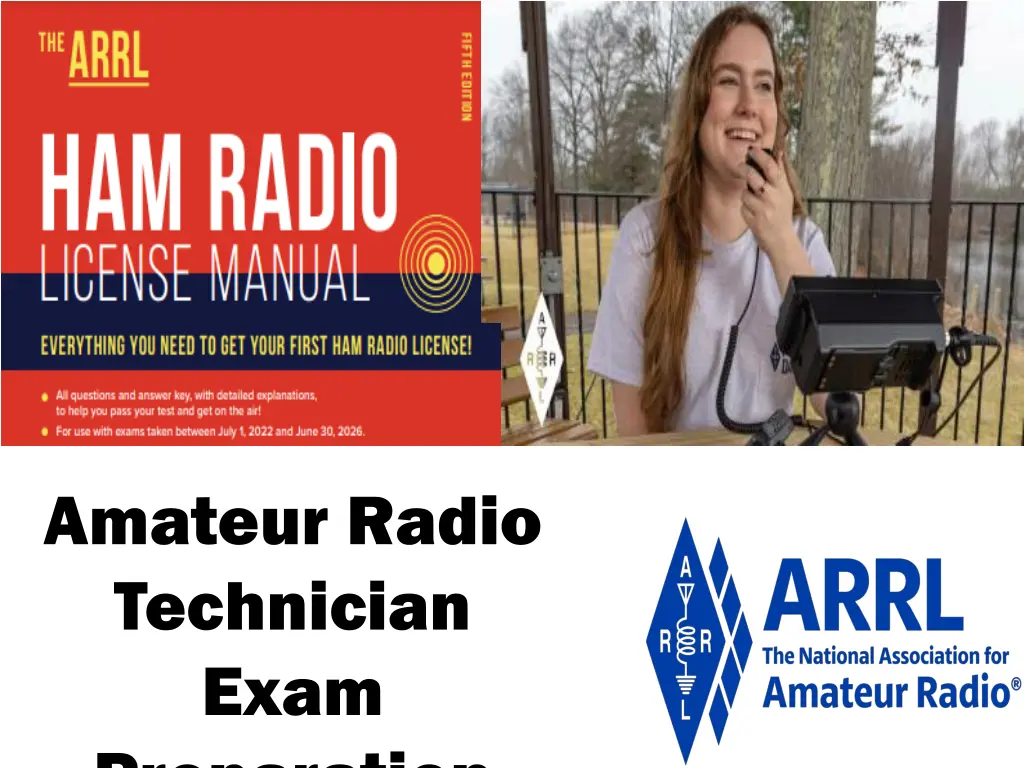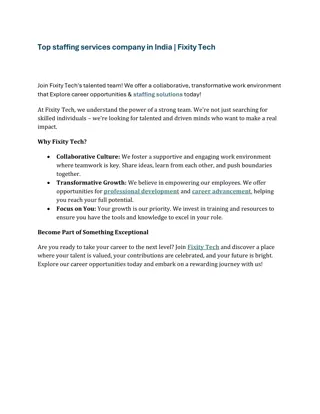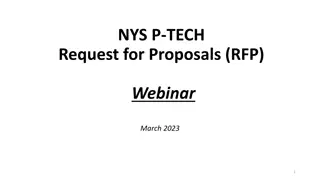
Amateur Radio Technician Exam Prep: Band Plans and Communication Tips
Prepare for your Amateur Radio Technician exam by learning about band plans, communicating with other hams, and operating on repeaters. Understand the voluntary agreements for band allocations, proper repeater etiquette, and making successful contacts. Explore the 2-meter band plan and frequency bands to enhance your knowledge for the exam.
Download Presentation

Please find below an Image/Link to download the presentation.
The content on the website is provided AS IS for your information and personal use only. It may not be sold, licensed, or shared on other websites without obtaining consent from the author. If you encounter any issues during the download, it is possible that the publisher has removed the file from their server.
You are allowed to download the files provided on this website for personal or commercial use, subject to the condition that they are used lawfully. All files are the property of their respective owners.
The content on the website is provided AS IS for your information and personal use only. It may not be sold, licensed, or shared on other websites without obtaining consent from the author.
E N D
Presentation Transcript
Amateur Radio Technician Exam Preparation
Amateur Radio Technician Exam Prep Course Module 6 Communicating With Other Hams 6.1 Band Plans 6.2 Making Contacts 6.3 Using Repeaters 6.4 Nets 6.5 Communications for Public Service 6.6 Satellite Operating
Band Plans Band plans are voluntary agreements designed for normal conditions (not regulations) Amateur Radio is the only service that can tune freely and use multiple modes within their allocations Amateur Radio Band Plan: www.arrl.org/band-plan See 2 meter band plan on following slide (Table 6.1)
Table 6.1: 2 meter (144-148 MHz) Band Plan 2 meter and 70 cm bands are where many Technician licensees begin operating Note the variety of activity in just one band
Band Plans (cont.) HF band plans tend to be simpler than VHF and UHF because there are no repeaters Other common uses listed in band plans Beacons Automated transmissions for listeners to tell when the band is open to the beacon s location Weak signal Modes that work better at lower signal strengths (CW, SSB, and some digital modes). Every amateur band from 50 MHz on up has frequencies available for CW and SSB operation. Satellite uplinks and downlinks Segments of bands where signals are sent to (uplink) and received from (downlink) satellites Simplex Transmitting and receiving on the same frequency Repeater inputs and outputs Control links
Frequency Bands Chart from arrl.org See slide INTERPRETIN G THE BAND PLAN
Interpreting the Band Plan Band (frequency) Use(s) License privilege( s) An EXTRA may use the 40 meter band for phone or image from 7.125 to 7.300 MHz.
Making Contacts on Repeaters Before you transmit, be sure you are authorized to use that frequency and mode Typical repeater manners Listen so that you are aware of someone using the repeater Keep transmissions short Identify your station legally Easiest way to attract listeners give your call sign followed by monitoring K ILP monitoring Responding to a station looking for a contact say the other station s call sign once, followed by this is or from, then give your call sign KX4IU this is K ILP
Making Contacts on Repeaters (cont.) If you accidentally interrupt someone just say Sorry, K ILP clear and wait for their contact to end or tune to a different repeater What if you receive a report that your signal s audio is strong, but distorted? You re slightly off-frequency (radio control knob got bumped) Speaking too loudly into the microphone Transmitting from a bad location Weak or low batteries
Making Contacts on Simplex Channels Simplex channels are conveniently located between bands of repeater input and output channels It s often quite easy to make contact directly, without use of a repeater avoids occupying or tying up a repeater Many radios have a reverse split function that swaps transmit and receive frequencies, enabling you to listen for the other station on the repeater s input frequency The national simplex calling frequency on 2
Making Contacts: SSB, CW, and DIGITAL Starting contacts is different on these modes than on repeaters that use fixed channels call must be long enough to attract attention Done by calling CQ(means I am calling any station. ) The station calling CQ sends or says CQ several times followed by their call sign CQ CQ CQ, this is K ILP Kilo Zero India Lima Papa calling CQ and standing by On CW or Digital: CQ CQ CQ DE K ILP K ILP K ILP K Before you call CQ you should do three
Q-Signals Q-signals are a system of radio shorthand (abbreviations for common information) developed from old telegraphy codes Although developed for use by Morse operators, their use is also common on phone/voice Table 6.2 lists the most common Q-signals
Table 6.2: Q- Signals Take the form of a question only when followed by a question mark.
DXing and Contesting DX stands for distant station Means thousands of miles on HF (and occasionally 6 meters) Beyond the radio horizon on VHF/UHF Best done on SSB or CW because of the efficiency of those modes Radio contests are held in which the competitors try to make as many short contacts as possible in a fixed period of time During contesting send only the minimum information needed to identify your station
Popular DXing Event www.arrl.org/field-day
Fox Hunting & Direction Finding A different and more physical type of contest is known as foxhunting Involves hiding and finding hidden transmitters Trains hams to find downed aircraft, lost hikers, and sources of interference or jamming You can get started with a portable radio with a signal strength indicator and a handheld or portable directional antenna
Video Two primary means of exchanging pictures or video in real-time Amateur television (ATV) on the UHF bands at 430 MHz and higher Fast-scan color television signals (NTSC National Television System Committee) Slow-scan television (SSTV) sends still signals More info on amateur radio imaging at: www.arrl.org/atv-fast-scan-amateur-television www.hamuniverse.com/atvfastscantv.html
Where may SSB phone be used in amateur bands above 50 MHz? A. Only in sub-bands allocated to General class or higher licensees B. Only on repeaters C. In at least some segment of all these bands D. On any band if the power is limited to 25 watts T1B10 C 97.305(c) 6-1
What is a band plan, beyond the privileges established by the FCC? A. A voluntary guideline for using different modes or activities within an amateur band B. A list of operating schedules C. A list of available net frequencies D. A plan devised by a club to indicate frequency band usage T2A10 A 6-1
What term describes an amateur station that is transmitting and receiving on the same frequency? A. Full duplex B. Diplex C. Simplex D. Multiplex T2A11 C 6-1
What is an appropriate way to call another station on a repeater if you know the other station s call sign? A. Say break, break, then say the station s call sign B. Say the station s call sign, then identify with your call sign C. Say CQ three times, then the other station s call sign D. Wait for the station to call CQ, then answer T2A04 B 6-4
Which of the following indicates that a station is listening on a repeater and looking for a contact? A. CQ CQ followed by the repeater s call sign B. The station s call sign followed by the word monitoring C. The repeater call sign followed by the station s call sign D. QSY followed by your call sign T2A09 B 6-4
What might be a problem if you receive a report that your audio signal through an FM repeater is distorted or unintelligible? A. Your transmitter is slightly off frequency B. Your batteries are running low C. You are in a bad location D. All these choices are correct T7B10 D 6-4
What is the national calling frequency for FM simplex operations in the 2 meter band? A. 146.520 MHz B. 145.000 MHz C. 432.100 MHz D. 446.000 MHz T2A02 A 6-6
How is a VHF/UHF transceivers reverse function used? A. To reduce power output B. To increase power output C. To listen on a repeater s input frequency D. To listen on a repeater s output frequency T2B01 C 6-6
Why are simplex channels designated in the VHF/UHF band plans? A. So stations within range of each other can communicate without tying up a repeater B. For contest operation C. For working DX only D. So stations with simple transmitters can access the repeater without automated offset T2B09 A 6-6
How should you respond to a station calling CQ? A. Transmit CQ followed by the other station s call sign B. Transmit your call sign followed by the other station s call sign C. Transmit the other station s call sign followed by your call sign D. Transmit a signal report followed by your call sign T2A05 C 6-6
What is the meaning of the procedural signal CQ ? A. Call on the quarter hour B. Test transmission, no reply expected C. Only the called station should transmit D. Calling any station T2A08 D 6-6
What should you do before calling CQ? A. Listen first to be sure that no one else is using the frequency B. Ask if the frequency is in use C. Make sure you are authorized to use that frequency D. All these choices are correct T2A12 D 6-6
Which Q signal indicates that you are receiving interference from other stations? A. QRM B. QRN C. QTH D. QSB T2B10 A 6-7
Which Q signal indicates that you are changing frequency? A. QRU B. QSY C. QSL D. QRZ T2B11 B 6-7
What operating activity involves contacting as many stations as possible during a specified period? A. Simulated emergency exercises B. Net operations C. Public service events D. Contesting T8C03 D 6-7
Which of the following is good procedure when contacting another station in a contest? A. Sign only the last two letters of your call if there are many other stations calling B. Contact the station twice to be sure that you are in his log C. Send only the minimum information needed for proper identification and the contest exchange D. All these choices are correct T8C04 C 6-7
What is a grid locator? A. A letter-number designator assigned to a geographic location B. A letter-number designator assigned to an azimuth and elevation C. An instrument for neutralizing a final amplifier D. An instrument for radio direction finding T8C05 A 6-8
What type of transmission is indicated by the term NTSC? A. A Normal Transmission mode in Static Circuit B. A special mode for satellite uplink C. An analog fast-scan color TV signal D. A frame compression scheme for TV signals T8D04 C 6-9
Which of the following methods is used to locate sources of noise interference or jamming? A. Echolocation B. Doppler radar C. Radio direction finding D. Phase locking T8C01 C 6-10
Which of these items would be useful for a hidden transmitter hunt? A. Calibrated SWR meter B. A directional antenna C. A calibrated noise bridge D. All these choices are correct T8C02 B 6-10






















